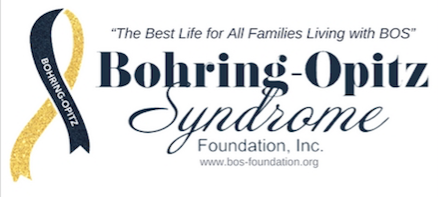The Hunsuckers met mice with BOS!
On Friday, November 18, 2016, our family had the opportunity to meet with two researchers at the University of Miami who are studying the gene that causes Bohring-Opitz Syndrome (BOS). Hazel, Greg, and I visited these scientists to learn more about current BOS research, and to find out how to further motivate and fund research on BOS.
Dr. Juan Young and Dr. Feng-Chun Yang were kind enough to meet with us for the morning so we could tour their labs, introduce them to Hazel, and learn about their research projects.
As many of you know, BOS is caused by a mutation on the ASXL1 gene. This mutation causes BOS at conception, but can also cause some forms of cancer when the ASXL1 gene mutates in adulthood.
First we met with Dr. Yang, who explained that she studies the molecules that cause cancer. She primarily researches mutations in the ASXL1, ASXL2, and ASXL3 genes. Her ultimate goal is to discover therapies to treat cancer.
Dr. Young is a neurobiologist who studies the genetic causes of inherited diseases. He works to create animal models who have genetic diseases. He is known for his work with a genetic disorder called Rett Syndrome. We are very fortunate that both doctors are medical advisors to the Bohring-Opitz Syndrome Foundation!
The doctors spent time giving us tours of their labs, introduced us to their colleagues and doctoral students, and were patient when our eyes glazed over at high-level scientific concepts. They were very interested in meeting Hazel, because neither had met a child with BOS before!

After learning about their research, Greg and I were able to reach the pinnacle of our visit — a chance to meet the mice that have BOS! Unfortunately, Hazel was not able to meet the mice (we promised her a trip to the pet store this week) because the animal model area is very sterile. We had to put on a ton of protective clothing, walk through an air bath, and wear masks so that we did not infect the mice with any outside contaminants.
Dr. Young brought us back to the mice room, and pulled out the tank containing the mice with BOS. The mice had just had pups in two of the containers, so we couldn’t disturb them. He pulled out an adult mouse and held it out for us to inspect. He then brought us to the mice testing area, where they have standardized tests and mazes to study things like anxiety, ability to learn, memory, and even empathy! We were amazed. We were able to ask Dr. Young about how the mice with BOS perform in the tests. He explained that the mice with BOS seem to have some learning disabilities and anxiety issues that typical mice do not have.
The purpose of testing the abilities of the mice with BOS is to eventually develop therapies that could help people with this mutation. This could even include gene therapy, which blew my mind. Imagine seeing gene therapy for children with BOS in our lifetime! (Let me make it clear that we are probably very far from this happening soon, but hey, one can hope.)
We then had to relieve Dr. Yang, who was kindly watching Hazel while we toured the animal model area.
Next, we met Dr. Mustafa Tekin, who is a clinical and molecular geneticist at U of M. He was gracious enough to meet Hazel between seeing patients at clinic, and we will be back to meet with him in clinic so that we can add to the knowledge mix of these researchers at the university.
So where do we go from here?
A BOS patient registry is going to greatly help further their research. One of our medical advisors, Dr. Bianca Russell, has one in the works, and is currently navigating the red tape involved with setting up a research registry. She hopes to launch it very soon, and it will be extremely important for all people affected by BOS.

Hazel meets BOS researcher Dr. Juan Young!
Doctors Young and Yang are connecting us with other researchers and partners to help us spread awareness of BOS and continue to motivate BOS research. Hazel, Greg and I will be attending the ACMG Annual Clinical Genetics Meeting in Phoenix in March of 2017 to continue to network with researchers and spread awareness of BOS. Hazel and I will meet with the doctors at the University of Miami on a regular basis to touch base on research (and to check on the mice!).
We had an amazing day, and are inspired and filled with hope to see the passion and dedication of these researchers.
A huge thank you to Dr. Young and Dr. Yang for spending so much time with us!
To help the BOS Foundation continue our progress in motivating BOS research, please donate today! Your donations will help us attend the ACMG Annual Meeting in Phoenix in March as well as other rare summit events throughout the year.
Donate via PayPal: https://www.paypal.me/bosfoundation
or
Send a check to: Bohring-Opitz Syndrome Foundation, P.O. Box 560475, Orlando, FL 32856
Thanks for your continued support! All November and December donations of $20 or more will receive a BOS holiday ornament. Donate before December 10 to get yours before the holidays!
Carrie Hunsucker
Chair
BOS Foundation
(View the original post at: https://tinyandfierce.com/2016/11/29/we-met-mice-with-bos/)
